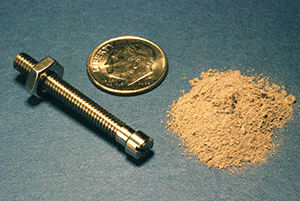Praxair uses Ames Laboratory’s advanced titanium atomisation technology for AM grade powders
December 14, 2015
Ames Laboratory, the US Department of Energy Office of Science national laboratory operated by Iowa State University, has announced that titanium powder created with its gas atomisation technology is now available from Praxair Inc. The fine, spherical titanium powder is suited for both Additive Manufacturing and Metal Injection Moulding of aerospace, medical and industrial parts. It marks the first time large-scale amounts of titanium powder are available to industry with a potential for low-cost, high-volume manufacturing, Ames stated.
“Titanium powder made with this technology has huge potential to save manufacturers materials and money,” stated Iver Anderson, a senior metallurgist at Ames Laboratory. “Creating titanium powder of high quality at great volumes was what we materials scientists called the Holy Grail of gas atomisation.”
Titanium’s strength, light weight, biocompatibility and resistance to corrosion make it ideal for use in parts ranging from aircraft wing structures to replacement knee joints and medical instruments. Using ultra-fine, high-purity spherical titanium powder to additively manufacture or mould these parts generates around ten times less metal waste than traditional casting of parts. However, ultra-fine titanium powder was nearly impossible to produce from the molten state because liquid titanium is readily contaminated by dissolved gases and can’t be contained by normal ceramic melting crucibles, which it can rapidly erode, to the point of spilling through, Ames stated.
“Our invention of an in-stream melt heating guide tube was critical to boost the melt temperature by at least 100˚C, allowing adaptation of water-cooled ‘clean’ melting technologies, normally used to melt and cast strong, reliable aerospace Ti parts,” stated Anderson. “This new ‘hot nozzle’ made possible precise feeding of highly energetic close-coupled atomizers for efficient production of fine Ti powders.”
Two members of Anderson’s research team, Joel Rieken and Andy Heidloff, created a spinoff company, Iowa Powder Atomization Technologies, and exclusively licensed Ames Laboratory’s titanium atomisation patents. IPAT worked to further optimise the titanium atomisation process and along the way won several business and technology awards for their efforts, including the Department of Energy’s Next Energy Innovator competition in 2012.
In 2014, IPAT was acquired by Praxair, a Fortune 250 company and one of the world’s largest producers of gases and surface coatings. Earlier this year, Praxair announced it had begun to market titanium powder.
“We talk regularly about the Department of Energy’s goal of transferring research from the scientist’s bench to the marketplace. This work is a strong example of how that goal can become reality. The ingenuity and continued hard work and commitment by our scientists and our licensee to get the technology to market cannot be underestimated. They make my job of transferring technology developed at Ames Laboratory into the marketplace so much easier,” said Ames Laboratory Associate Director Debra Covey.
Gas atomisation work at Ames Laboratory was supported by the Department of Energy’s Office of Science and Office of Fossil Energy, and the specific work on titanium powder was supported by Iowa State University’s Research Foundation, the State of Iowa Regents Innovation Fund, and the U.S. Army.

















